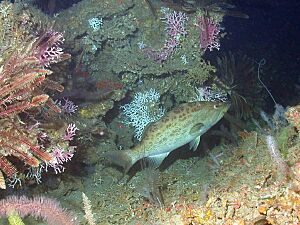Scamp grouper facts for kids
Quick facts for kids Scamp grouper |
|
|---|---|
 |
|
| Conservation status | |
| Scientific classification |
The scamp grouper (Mycteroperca phenax) is a cool fish that lives in the ocean. It's also called just "scamp." This fish is a type of grouper, which belongs to a bigger family of fish called Serranidae. This family also includes sea basses. You can find scamp groupers in the western part of the Atlantic Ocean.
Contents
What Does the Scamp Grouper Look Like?
The scamp grouper has a long, strong body that's a bit flat on the sides. It's about the same height from its back fin to its belly fin. The fish's total length can be up to 107 cm (about 42 inches). But usually, they are around 30 cm (about 12 inches) long. The heaviest scamp ever found weighed about 14.2 kg (31 pounds).
Scamp Grouper Colors and Patterns
Scamp groupers can have four different looks!
- One common look is a light brown body covered in small, dark reddish-brown spots. These spots often look like paw prints. They can form saddle-like patches on the back and long blotches on the sides.
- Another look is also light brown, but with dark brown spots on the upper body that look like cat's paws.
- Big adult scamps can be silvery-gray on their head and front. The back two-thirds of their body are dark. They might have a few white spots on their belly and near their tail.
- The fourth look is two-colored. It's light brown in the front and suddenly turns dark from the middle of its back fin. Young scamp groupers don't have this two-colored look.
Their fins also have special patterns. The tail fin is usually dark with a light edge.
Where Do Scamp Groupers Live?
Scamp groupers live in the western Atlantic Ocean. You can find them from North Carolina down to the southern coast of the United States. They are also in the Gulf of Mexico, as far south as Belize. They are not found in most of the West Indies. You can also see them along the Caribbean coast of South America, from Colombia to Tobago.
Sometimes, young scamp groupers travel far north, even to Massachusetts. One scamp even wandered all the way to the Azores islands!
Scamp Grouper's Home and Life
Scamp groupers live in water from 0 to 100 meters (0 to 328 feet) deep. Adult scamps like rocky areas with lots of ledges and bumps, usually deeper than 30 meters (98 feet). Young scamps live in shallower reefs. They can even go into estuaries (where rivers meet the sea) and mangrove areas.
Moving for Warmth
Adult scamps will move from deep water to shallower water if the temperature drops too low. They don't like it when the water gets colder than 8.6°C (47.5°F) at the bottom.
How Scamp Groupers Reproduce
Scamp groupers are special because they can change their sex! They start out as females and later change into males. They gather in small groups to lay their eggs. These groups can have anywhere from ten to a few hundred fish. They meet over rocky reefs along the edge of the continental shelf. This happens from February to July in the United States, usually peaking from March to mid-May.
Why They Like Rocky Homes
Scamps are very common in areas with special Oculina reefs off the coast of Florida. These reefs are between 70 and 100 meters (230 and 328 feet) deep. Scientists think scamps like places with lots of hiding spots like overhangs, ledges, and caves. Since they are not very big, these spots help them hide from predators like sharks and greater amberjack.
What Scamp Groupers Eat
Scamp groupers are hunters! They eat other fish, crabs and other creatures that live on the ocean floor, and octopuses.
Who Named the Scamp Grouper?
The scamp grouper was first officially described in 1884. It was named by two American scientists: David Starr Jordan, who studied fish, and Joseph Swain, a biologist and mathematician. They found and described this fish near Key West and Pensacola in Florida.
Fishing and Protecting Scamp Groupers
The scamp grouper is a popular fish for both sport fishing and commercial fishing. People really like it because its meat is white, tastes sweet, and is very good to eat.
The name "scamp" might come from how good they are at stealing bait from fishing hooks without getting caught!
Scientists don't have enough information about how many scamp groupers there are in many parts of the ocean. Fishing is a big threat to them. Because of this, the IUCN (a group that studies nature) has listed the scamp grouper as "Data Deficient." This means they don't have enough information to know if the fish is in danger or not.
USS Scamp Submarines
Two United States Navy submarines have been named after the scamp grouper!
- The first was USS Scamp (SS-277), which was active from 1942 to 1944.
- The second was USS Scamp (SSN-588), which was active from 1960 to 1988.


